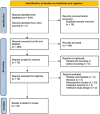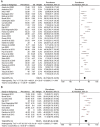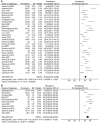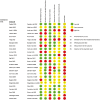The prevalence of the failure of fixed orthodontic bonded retainers: a systematic review and meta-analysis
- PMID: 37824794
- PMCID: PMC10687514
- DOI: 10.1093/ejo/cjad047
The prevalence of the failure of fixed orthodontic bonded retainers: a systematic review and meta-analysis
Erratum in
-
Correction to: The prevalence of the failure of fixed orthodontic bonded retainers: a systematic review and meta-analysis.Eur J Orthod. 2024 Apr 1;46(2):cjae007. doi: 10.1093/ejo/cjae007. Eur J Orthod. 2024. PMID: 38345244 Free PMC article. No abstract available.
Abstract
Objectives: To systematically assess the scientific literature for the prevalence of failure rate of fixed orthodontic bonded retainer (FOBR).
Method: Randomized clinical trials (RCTs) and prospective non-RCTs involving participants who had FOBR fitted were included. The Cochrane Central Register of Controlled Trials, Web of science, MEDLINE, and EMBASE via OVID were searched from inception to January 2023. Risk of bias was assessed using the Cochrane RoB 2 and Newcastle-Ottawa tools. The main outcome was the failure rate of FOBRs. The secondary outcome was to identify factors that can influence the failure of FOBR. Meta-analyses and sensitivity analyses were undertaken using Revman, version5.4. A random-effects model was used. Quality assessment using Grading of Recommendations Assessment, Development, and Evaluation.
Results: Thirty-four studies (25 RCTs and 9 prospective clinical studies) (3484 participants) were included in this review. The overall failure rate of bonded retainers, after excluding high-risk studies, was 35.22% (95% confidence interval [CI] 27.46-42.98). The failure rate is increased with the duration of follow up; with short-term follow-up rate 24.18% (95% CI 20.16-28.21), medium-term follow up 40.09% (95% CI 30.92-49.26), and long-term follow up 53.85% (95% CI 40.31-67.39). There is a low level of evidence to suggest there is no statistically significant difference in the failure rate of fixed retainers using direct versus indirect bonding methods, using liquid resin versus without liquid resin, and fibre-reinforced composite retainers compared to multi-stranded stainless steel retainers.
Discussion: There is low-quality evidence to suggest that the failure rate of FOBR is relatively high. There is a need for high-quality, well-reported clinical studies to assess factors that can influence the failure rate of FOBR.
Registration: CRD42021190910.
© The Author(s) 2023. Published by Oxford University Press on behalf of the European Orthodontic Society.
Conflict of interest statement
The authors declare that there is no conflict of interest.
Figures











